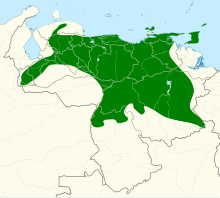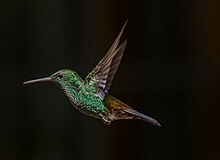Copper-rumped hummingbird: Difference between revisions
Pvmoutside (talk | contribs) |
mention move from Amazilia, add sections per WP:Birds |
||
| Line 20: | Line 20: | ||
The '''copper-rumped hummingbird''' (''Saucerottia tobaci'') is a small [[bird]] that breeds in [[Venezuela]], [[Trinidad]] and [[Tobago]], and has occurred as a [[Vagrancy (biology)|vagrant]] on [[Grenada]]. It is a seasonal [[bird migration|migrant]] in parts of Venezuela. |
The '''copper-rumped hummingbird''' (''Saucerottia tobaci'') is a small [[bird]] that breeds in [[Venezuela]], [[Trinidad]] and [[Tobago]], and has occurred as a [[Vagrancy (biology)|vagrant]] on [[Grenada]]. It is a seasonal [[bird migration|migrant]] in parts of Venezuela. |
||
==Taxonomy== |
|||
| ⚫ | This [[hummingbird]] inhabits open country, gardens and cultivation. The female copper-rumped hummingbird lays its eggs in a tiny cup nest on a low branch, or sometimes wires or clotheslines. [[avian incubation|Incubation]] takes 16–17 days, and [[fledge|fledging]] another 19–23, and there may be up to three broods in a season. It is the predominant species of hummingbird in Trinidad and Tobago. |
||
This species was formerly placed in the [[genus]] ''[[Amazilia]]''. A [[molecular phylogenetic]] study published in 2014 found that the genus ''Amazilia'' was [[polyphyletic]].<ref>{{ cite journal | last1=McGuire | first1=J. | last2=Witt | first2=C. | last3=Remsen | first3=J.V. | last4=Corl | first4=A. | last5=Rabosky | first5=D. | last6=Altshuler | first6=D. | last7=Dudley | first7=R. | date=2014 | title=Molecular phylogenetics and the diversification of hummingbirds | journal=Current Biology | volume=24 | issue=8 | pages=910-916 | doi=10.1016/j.cub.2014.03.016 | doi-access=free }}</ref> In the revised classification to create [[monophyletic]] genera, the copper-rumped hummingbird was moved to the resurrected genus ''[[Saucerottia]]''.<ref>{{ cite journal | last1=Stiles | first1=F.G. | last2=Remsen | first2=J.V. Jr. | last3=Mcguire | first3=J.A. | year=2017 | title=The generic classification of the Trochilini (Aves: Trochilidae): Reconciling taxonomy with phylogeny | journal=Zootaxa | volume=4353 | issue=3 | pages=401-424 | doi=10.11646/zootaxa.4353.3 | url=https://www.researchgate.net/profile/J_Remsen/publication/321277435 }}</ref><ref name=ioc>{{cite web| editor1-last=Gill | editor1-first=Frank | editor1-link=Frank Gill (ornithologist) | editor2-last=Donsker | editor2-first=David | editor3-last=Rasmussen | editor3-first=Pamela | editor3-link=Pamela Rasmussen | date=July 2020 | title=Hummingbirds | work=IOC World Bird List Version 10.2 | url=http://www.worldbirdnames.org/bow/hummingbirds/ | publisher=International Ornithologists' Union | accessdate=8 January 2020 }}</ref> |
|||
==Description== |
|||
The copper-rumped hummingbird is 8.6 cm long and weighs 4.7 g. The bill is fairly long, straight and mostly black with some pink on the lower mandible. The adult has copper-green upperparts, becoming copper-bronze on the rump. The head and underparts are bright green, the thighs are white and the tail and legs are black. The sexes are similar. |
The copper-rumped hummingbird is 8.6 cm long and weighs 4.7 g. The bill is fairly long, straight and mostly black with some pink on the lower mandible. The adult has copper-green upperparts, becoming copper-bronze on the rump. The head and underparts are bright green, the thighs are white and the tail and legs are black. The sexes are similar. |
||
| ⚫ | |||
==Distribution and habitat== |
|||
| ⚫ | This [[hummingbird]] inhabits open country, gardens and cultivation. The female copper-rumped hummingbird lays its eggs in a tiny cup nest on a low branch, or sometimes wires or clotheslines. [[avian incubation|Incubation]] takes 16–17 days, and [[fledge|fledging]] another 19–23, and there may be up to three broods in a season. It is the predominant species of hummingbird in Trinidad and Tobago. |
||
The subspecies which breeds in Trinidad, ''S. t. erythronotos'', is smaller and has more bronzing on the upperparts than the nominate ''S. t. tobaci'' of Tobago. The latter race has occurred as a vagrant to Grenada. There are several other subspecies in Venezuela differing mainly size and in the colour of the rump and back. |
The subspecies which breeds in Trinidad, ''S. t. erythronotos'', is smaller and has more bronzing on the upperparts than the nominate ''S. t. tobaci'' of Tobago. The latter race has occurred as a vagrant to Grenada. There are several other subspecies in Venezuela differing mainly size and in the colour of the rump and back. |
||
==Behaviour== |
|||
The food of this hummingbird is [[nectar]], taken from a wide variety of [[flower]]s, and some small [[insect]]s. Copper-rumped hummingbirds perch conspicuously and defend their territories aggressively against other hummingbirds, [[bee]]s, and larger bird species; this is especially during mating season, which is early in the year. |
The food of this hummingbird is [[nectar]], taken from a wide variety of [[flower]]s, and some small [[insect]]s. Copper-rumped hummingbirds perch conspicuously and defend their territories aggressively against other hummingbirds, [[bee]]s, and larger bird species; this is especially during mating season, which is early in the year. |
||
| ⚫ | |||
== References == |
== References == |
||
Revision as of 15:43, 8 January 2021
| Copper-rumped hummingbird | |
|---|---|

| |
| S. t. erythronota, Trinidad | |

| |
| S. t. tobaci, Tobago | |
| Scientific classification | |
| Domain: | Eukaryota |
| Kingdom: | Animalia |
| Phylum: | Chordata |
| Class: | Aves |
| Clade: | Strisores |
| Order: | Apodiformes |
| Family: | Trochilidae |
| Genus: | Saucerottia |
| Species: | S. tobaci
|
| Binomial name | |
| Saucerottia tobaci (Gmelin, 1788)
| |

| |
| Range in green | |
| Synonyms | |
|
Saucerottia tobaci | |

The copper-rumped hummingbird (Saucerottia tobaci) is a small bird that breeds in Venezuela, Trinidad and Tobago, and has occurred as a vagrant on Grenada. It is a seasonal migrant in parts of Venezuela.
Taxonomy
This species was formerly placed in the genus Amazilia. A molecular phylogenetic study published in 2014 found that the genus Amazilia was polyphyletic.[2] In the revised classification to create monophyletic genera, the copper-rumped hummingbird was moved to the resurrected genus Saucerottia.[3][4]
Description
The copper-rumped hummingbird is 8.6 cm long and weighs 4.7 g. The bill is fairly long, straight and mostly black with some pink on the lower mandible. The adult has copper-green upperparts, becoming copper-bronze on the rump. The head and underparts are bright green, the thighs are white and the tail and legs are black. The sexes are similar.
The call of this species is a chip, and the song is a high-pitched tyee-tyee-tyoo.
Distribution and habitat
This hummingbird inhabits open country, gardens and cultivation. The female copper-rumped hummingbird lays its eggs in a tiny cup nest on a low branch, or sometimes wires or clotheslines. Incubation takes 16–17 days, and fledging another 19–23, and there may be up to three broods in a season. It is the predominant species of hummingbird in Trinidad and Tobago.
The subspecies which breeds in Trinidad, S. t. erythronotos, is smaller and has more bronzing on the upperparts than the nominate S. t. tobaci of Tobago. The latter race has occurred as a vagrant to Grenada. There are several other subspecies in Venezuela differing mainly size and in the colour of the rump and back.
Behaviour
The food of this hummingbird is nectar, taken from a wide variety of flowers, and some small insects. Copper-rumped hummingbirds perch conspicuously and defend their territories aggressively against other hummingbirds, bees, and larger bird species; this is especially during mating season, which is early in the year.
References
- ^ BirdLife International (2012). "Amazilia tobaci". IUCN Red List of Threatened Species. 2012. Retrieved 26 November 2013.
{{cite journal}}: Invalid|ref=harv(help) - ^ McGuire, J.; Witt, C.; Remsen, J.V.; Corl, A.; Rabosky, D.; Altshuler, D.; Dudley, R. (2014). "Molecular phylogenetics and the diversification of hummingbirds". Current Biology. 24 (8): 910–916. doi:10.1016/j.cub.2014.03.016.
- ^ Stiles, F.G.; Remsen, J.V. Jr.; Mcguire, J.A. (2017). "The generic classification of the Trochilini (Aves: Trochilidae): Reconciling taxonomy with phylogeny". Zootaxa. 4353 (3): 401–424. doi:10.11646/zootaxa.4353.3.
- ^ Gill, Frank; Donsker, David; Rasmussen, Pamela, eds. (July 2020). "Hummingbirds". IOC World Bird List Version 10.2. International Ornithologists' Union. Retrieved 8 January 2020.
- ffrench, Richard (1991). A Guide to the Birds of Trinidad and Tobago (2nd ed.). Comstock Publishing. ISBN 0-8014-9792-2.
- Hilty, Steven L (2003). Birds of Venezuela. London: Christopher Helm. ISBN 0-7136-6418-5.

